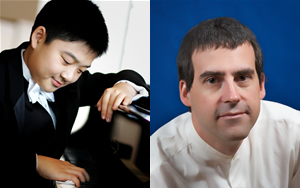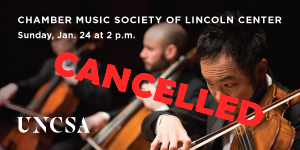On Sunday afternoon, sixteen-year-old Christopher Tavernier presented a demanding full-length piano recital at Flat Rock Playhouse Downtown on Hendersonville’s historic Main Street. This concert, sponsored by the Music Foundation of Western North Carolina and Agudas Israel Congregation, featured romantic and twentieth-century composers, especially Tavernier’s favorite composer Franz Liszt, who wrote three of the ten pieces on the program and also the one encore.
I first heard Tavernier perform when he was age nine and showed up at an informal performance group sponsored by the Asheville Area Piano Forum. The other performers were local teachers and advanced amateurs, but this polite young man fit right in. He was a colleague. He startled me with his technique even then, and I have been pleased to see him blossom over the last seven years, working with his teacher John Cobb.
Normally, a recital by a student pianist should be judged in context: the performer is a work in progress. Students improve their technique year by year as a result of diligent practice. Students develop their musical sensibility year by year as they mature and broaden their repertoire, as they explore the emotional depths of great music. But Tavernier is different. His technique is astounding, and he has already a mature understanding of his favorite repertoire. So even now, I judge his Liszt, Chopin and Debussy by the standards I would apply to a working professional.
The concert began with the Prelude & Fugue in F minor, BWV 881, from the second volume of J.S. Bach’s Well-Tempered Clavier. Tavernier made full use of the capabilities of the piano, with voicing and dynamics that can’t be achieved on a harpsichord. I think Bach would have been pleased with this choice. Bach liked the early fortepianos that he encountered in his later years, and scholars believe that the concerto for three keyboards was premiered by three Bachs on three fortepianos, not three harpsichords. I liked the slight touch of rubato that Tavernier used; he might want to experiment with even more use of rubato in the introspective prelude. Many musicians play Bach metronomically, thinking this historically accurate, but in fact no one knows how much rubato J.S. Bach used.
The second work was the first movement (Allegro con brio) of Ludwig van Beethoven’s great middle-period Sonata in C, Op. 53, known as the “Waldstein.” Beethoven deals with emotional subjects such as heroism, fate, tragedy, and the affirmation of life despite its woes. This is heavy stuff for a sixteen-year-old. My favorite recording of the “Waldstein” is by Solomon (the British pianist Solomon Cutner), and that performance brings shivers to me. But that recording was not made by a sixteen-year-old Solomon (who performed first as a child prodigy) but by an adult Solomon shortly before he had the stroke that paralyzed his right arm at age 56, ending his performing career. Tavernier has many years ahead of him to develop his approach to Beethoven.
The first half of the concert highlighted three pieces performed as a group, two by Franz Liszt and one by Prokofiev. Liszt’s “Saint Francis of Paola Walking on the Waves” is a programmatic piece with great emotion and religious fervor. Liszt’s Hungarian Rhapsody No. 14 in F minor is taken from traditional Hungarian folk tunes. Prokofiev’s Toccata, Op. 11 is an early work, and much more abstract than the Liszt. This was very intelligent programming, and the three together were even more meaningful than they would have been taken separately. And all three are incredibly difficult technically, which did not faze Tavernier.
Following intermission, another most appropriate grouping of three pieces included two by Frédéric Chopin and one by Liszt. Chopin’s Etude in C, Op. 10, No. 1, with its glistening arpeggios was followed by Chopin’s Nocturne in C minor, Op. 48, No. 1 played with reserve in the early measures and with wild emotion breaking through in later passages. This was a highly personal rendering of the work, a well-conceived interpretation that left me with very strong afterthoughts. It shows the developing maturity of this performer. The third piece in the group was the Liszt “Transcendental Etude No. 8” (Wild Hunt). Liszt wrote a set of twelve etudes when he was fifteen years old. He then revised them over many years, adding immense complexity. Twenty-five years after the early publication, he published his final version of them as Transcendental Etudes. They are diabolically difficult to play, but when mastered are brilliant musical statements, an apotheosis of romantic piano.
A quiet interlude was provided with Claude Debussy’s impressionistic “Reflets dans l’eau” (Reflections in the Water) from the first volume of Images. The soloist was appropriately reflective and aware of his sound and its decay. I was put in mind of the great Walter Gieseking recording.
The final programmed work was Sergei Prokofiev’s Sonata No. 7, Op. 83, composed during World War Two. This sonata is highly dissonant. Its finale is marked “Precipitato,” the only occasion I have ever encountered this word. Again, the programming was very thoughtful, since this choice meant that each half of the program ended with a Prokofiev toccata, one a youthful work and the other a mature composition.
The tasteful encore was the quiet “Consolation No. 5” by Liszt. Tavernier has a depth of feeling for Liszt that is remarkable.












